Evaluation of WRF-Downscaled CMIP5 Climate Simulations for Precipitation and Temperature over Thailand (1976–2005): Implications for Adaptation and Sustainable Development
Abstract
1. Introduction
2. Data and Methods
2.1. Study Area and Model Domains
2.2. Data Sources
2.3. WRF Model Configuration
2.4. Evaluation Metrics
2.4.1. Statistical Measures
2.4.2. Distributional Analysis
2.4.3. Spatial and Temporal Analysis
3. Results
3.1. Precipitation Evaluation
3.1.1. Spatial and Temporal Precipitation Characteristics
3.1.2. Precipitation Distributional Analysis
3.2. Temperature Evaluation
3.2.1. Spatial and Temporal Maximum Temperature Characteristics
3.2.2. Maximum Temperature Distributional Analysis
3.2.3. Spatial and Temporal Minimum Temperature Characteristics
3.2.4. Minimum Temperature Distributional Analysis
3.3. Model Performance Metrics
3.3.1. Temperature Performance
3.3.2. Precipitation Performance
4. Discussion
4.1. Added Value of WRF Downscaling for Thailand
4.2. Systematic Biases and Their Implications
4.3. Relevance for Climate Adaptation and Resilience
4.4. Toward Future Climate Projections and Sustainable Development
4.5. Uncertainties and Limitations
5. Conclusions
Author Contributions
Funding
Institutional Review Board Statement
Informed Consent Statement
Data Availability Statement
Acknowledgments
Conflicts of Interest
References
- IPCC; Masson-Delmotte, V.; Zhai, P.; Pirani, A.; Connors, S.L.; Péan, C.; Berger, S.; Caud, N.; Chen, Y.; Goldfarb, L.; et al. Climate Change 2021: The Physical Science Basis. Contribution of Working Group I to the Sixth Assessment Report of the Intergovernmental Panel on Climate Change; Cambridge University Press: Cambridge, UK, 2021. [Google Scholar]
- Kamworapan, S.; Surussavadee, C. Evaluation of CMIP5 Global Climate Models for Simulating Climatological Temperature and Precipitation for Southeast Asia. Adv. Meteorol. 2019, 2019, 1067365. [Google Scholar] [CrossRef]
- Tangang, F.; Santisirisomboon, J.; Juneng, L.; Salimun, E.; Chung, J.; Supari, S.; Cruz, F.; Ngai, S.T.; Ngo-Duc, T.; Singhruck, P.; et al. Projected Future Changes in Mean Precipitation over Thailand Based on Multi-model Regional Climate Simulations of CORDEX Southeast Asia. Int. J. Climatol. 2019, 39, 5413–5436. [Google Scholar] [CrossRef]
- Maichandee, S.; Namwong, P.; Methakeson, O. Impacts of Climate Change and Regional Variations on Future Rainfall Patterns in Thailand by Downscaling Method. ASEAN J. Sci. Technol. Rep. 2023, 27, 80–91. [Google Scholar] [CrossRef]
- Kimmany, B.; Visessri, S.; Pech, P.; Ekkawatpanit, C. The Impact of Climate Change on Hydro-Meteorological Droughts in the Chao Phraya River Basin, Thailand. Water 2024, 16, 1023. [Google Scholar] [CrossRef]
- Masud, M.B.; Soni, P.; Shrestha, S.; Tripathi, N.K. Changes in Climate Extremes over North Thailand, 1960–2099. J. Climatol. 2016, 2016, 4289454. [Google Scholar] [CrossRef]
- Shrestha, S.; Lohpaisankrit, W. Flood Hazard Assessment under Climate Change Scenarios in the Yang River Basin, Thailand. Int. J. Sustain. Built Environ. 2017, 6, 285–298. [Google Scholar] [CrossRef]
- Kure, S.; Tebakari, T. Hydrological Impact of Regional Climate Change in the Chao Phraya River Basin, Thailand. Hydrol. Res. Lett. 2012, 6, 53–58. [Google Scholar] [CrossRef]
- Khampeera, A.; Yongchalermchai, C.; Techato, K. Drought Monitoring Using Drought Indices and Gis Techniques in Kuan Kreng Peat Swamp, Southern Thailand. Walailak J. Sci. Technol. 2018, 15, 357–370. [Google Scholar] [CrossRef]
- Homdee, T.; Pongput, K.; Kanae, S. A Comparative Performance Analysis of Three Standardized Climatic Drought Indices in the Chi River Basin, Thailand. Agric. Nat. Resour. 2016, 50, 211–219. [Google Scholar] [CrossRef]
- Taylor, K.E.; Stouffer, R.J.; Meehl, G.A. An Overview of CMIP5 and the Experiment Design. Bull. Am. Meteorol. Soc. 2012, 93, 485–498. [Google Scholar] [CrossRef]
- Pan, Z.; Zhang, Y.; Liu, X.; Gao, Z. Current and Future Precipitation Extremes over Mississippi and Yangtze River Basins as Simulated in CMIP5 Models. J. Earth Sci. 2016, 27, 22–36. [Google Scholar] [CrossRef]
- Chen, F.; Dudhia, J. Coupling and Advanced Land Surface-Hydrology Model with the Penn State-NCAR MM5 Modeling System. Part I: Model Implementation and Sensitivity. Mon. Weather Rev. 2001, 129, 569–585. [Google Scholar] [CrossRef]
- Sonali, P.; Nagesh Kumar, D. Review of Recent Advances in Climate Change Detection and Attribution Studies: A Large-Scale Hydroclimatological Perspective. J. Water Clim. Change 2020, 11, 1–29. [Google Scholar] [CrossRef]
- Zehr, S.C. Public Representations of Scientific Uncertainty about Global Climate Change. Public Underst. Sci. 2000, 9, 85. [Google Scholar] [CrossRef]
- Shen, M.; Chen, J.; Zhuan, M.; Chen, H.; Xu, C.Y.; Xiong, L. Estimating Uncertainty and Its Temporal Variation Related to Global Climate Models in Quantifying Climate Change Impacts on Hydrology. J. Hydrol. 2018, 556, 10–24. [Google Scholar] [CrossRef]
- Takayabu, I.; Ishizaki, N.N.; Nakaegawa, T.; Sasaki, H.; Wongseree, W. Potential of Representing the Diurnal Cycle of Local-Scale Precipitation in Northeastern Thailand Using 5-Km and 2-Km Grid Regional Climate Models. Hydrol. Res. Lett. 2021, 15, 1–8. [Google Scholar] [CrossRef]
- Hariadi, M.H.; van der Schrier, G.; Steeneveld, G.; Sopaheluwakan, A.; Tank, A.K.; Roberts, M.J.; Moine, M.; Bellucci, A.; Senan, R.; Tourigny, E.; et al. Evaluation of Onset, Cessation and Seasonal Precipitation of the Southeast Asia Rainy Season in CMIP5 Regional Climate Models and HighResMIP Global Climate Models. Int. J. Climatol. 2022, 42, 3007–3024. [Google Scholar] [CrossRef]
- Cruz, F.T.; Narisma, G.T.; Dado, J.B.; Singhruck, P.; Tangang, F.; Linarka, U.A.; Wati, T.; Juneng, L.; Phan-Van, T.; Ngo-Duc, T.; et al. Sensitivity of Temperature to Physical Parameterization Schemes of RegCM4 over the CORDEX-Southeast Asia Region. Int. J. Climatol. 2017, 37, 5139–5153. [Google Scholar] [CrossRef]
- Tangang, F.; Chung, J.X.; Juneng, L.; Supari; Salimun, E.; Ngai, S.T.; Jamaluddin, A.F.; Mohd, M.S.F.; Cruz, F.; Narisma, G.; et al. Projected Future Changes in Rainfall in Southeast Asia Based on CORDEX–SEA Multi-Model Simulations. Clim. Dyn. 2020, 55, 1247–1267. [Google Scholar] [CrossRef]
- Chotamonsak, C.; Salathé, E.P.; Kreasuwan, J.; Chantara, S.; Siriwitayakorn, K. Projected Climate Change over Southeast Asia Simulated Using a WRF Regional Climate Model. Atmos. Sci. Lett. 2011, 12, 213–219. [Google Scholar] [CrossRef]
- Ratna, S.; Ratnam, J.; Behera, S.; Tangang, F.; Yamagata, T. Validation of the WRF Regional Climate Model over the Subregions of Southeast Asia: Climatology and Interannual Variability. Clim. Res. 2017, 71, 263–280. [Google Scholar] [CrossRef][Green Version]
- Saesong, T.; Ratjiranukool, P.; Ratjiranukool, S. Evaluation of Temperature Simulation over Northern Thailand from Regional Climate Model Coupled with Land Surface Model. Appl. Mech. Mater. 2017, 866, 108–111. [Google Scholar] [CrossRef]
- Ratjiranukool, P.; Ratjiranukool, S. Projection of Extreme Temperature over Northern Thailand by WRF Model. Appl. Mech. Mater. 2017, 866, 104–107. [Google Scholar] [CrossRef]
- Chhin, R.; Oeurng, C.; Yoden, S. Drought Projection in the Indochina Region Based on the Optimal Ensemble Subset of CMIP5 Models. Clim. Change 2020, 162, 687–705. [Google Scholar] [CrossRef]
- Nath, R.; Cui, X.; Nath, D.; Graf, H.F.; Chen, W.; Wang, L.; Gong, H.; Li, Q. CMIP5 Multimodel Projections of Extreme Weather Events in the Humid Subtropical Gangetic Plain Region of India. Earths Future 2017, 5, 224–239. [Google Scholar] [CrossRef]
- Zhang, Y.; You, Q.; Chen, C.; Ge, J.; Adnan, M. Evaluation of Downscaled CMIP5 Coupled with VIC Model for Flash Drought Simulation in a Humid Subtropical Basin, China. J. Clim. 2018, 31, 1075–1090. [Google Scholar] [CrossRef]
- Harding, K.J.; Snyder, P.K.; Liess, S. Use of Dynamical Downscaling to Improve the Simulation of Central U.S. Warm Season Precipitation in CMIP5 Models. J. Geophys. Res. Atmos. 2013, 118, 12-522–12-536. [Google Scholar] [CrossRef]
- Rojpratak, S.; Supharatid, S. Regional Extreme Precipitation Index: Evaluations and Projections from the Multi-Model Ensemble CMIP5 over Thailand. Weather Clim. Extrem. 2022, 37, 100475. [Google Scholar] [CrossRef]
- Supharatid, S.; Aribarg, T.; Supratid, S. Assessing Potential Flood Vulnerability to Climate Change by CMIP3 and CMIP5 Models: Case Study of the 2011 Thailand Great Flood. J. Water Clim. Change 2016, 7, 52–67. [Google Scholar] [CrossRef]
- De Silva, Y.K.; Babel, M.S.; Abatan, A.A.; Khadka, D.; Shanmugasundaram, J. Evaluation of ENSO in CMIP5 and CMIP6 Models and Its Significance in the Rainfall in Northeast Thailand. Theor. Appl. Clim. 2023, 154, 881. [Google Scholar] [CrossRef]
- Limsakul, A.; Limjirakan, S.; Suttamanuswong, B. Asian Summer Monsoon and Its Associated Rainfall Variability in Thailand. Environ. Asia 2010, 3, 79–89. [Google Scholar]
- Khedari, J.; Sangprajak, A.; Hirunlabh, J. Thailand Climatic Zones. Renew Energy 2002, 25, 267–280. [Google Scholar] [CrossRef]
- Monaghan, A.J.; Steinhoff, D.F.; Bruyere, C.L.; Yates, D. NCAR CESM Global Bias-Corrected CMIP5 Output to Support WRF/MPAS Research; Research Data Archive at the National Center for Atmospheric Research, Computational and Information Systems Laboratory: Boulder, CO, USA, 2014; p. 25. [Google Scholar]
- Harris, I.; Osborn, T.J.; Jones, P.; Lister, D. Version 4 of the CRU TS Monthly High-Resolution Gridded Multivariate Climate Dataset. Sci. Data 2020, 7, 109. [Google Scholar] [CrossRef] [PubMed]
- Skamarock, W.C.; Klemp, J.B.; Dudhia, J.; Gill, D.O.; Liu, Z.; Berner, J.; Wang, W.; Powers, J.G.; Duda, M.G.; Barker, D.M.; et al. A Description of the Advanced Research WRF Version 4; NCAR tech. note ncar/tn-556+ str; National Science Foundation: Boulder, CO, USA, 2019.
- Chotamonsak, C.; Salathe, E.; Kreasuwan, J.; Chantara, S. Evaluation of Precipitation Simulations over Thailand Using a WRF Regional Climate Model. Chiang Mai J. Sci. 2012, 39, 623–638. [Google Scholar]
- Hong, S.-Y.; Lim, J.-O.J. Hongandlim-JKMS-2006. J. Korean Meteorol. Soc. 2006, 42, 129–151. [Google Scholar]
- Kain, J.S.; Kain, J. The Kain-Fritsch Convective Parameterization: An Update. J. Appl. Meteorol. 2004, 43, 170–181. [Google Scholar] [CrossRef]
- Iacono, M.J.; Delamere, J.S.; Mlawer, E.J.; Shephard, M.W.; Clough, S.A.; Collins, W.D. Radiative Forcing by Long-Lived Greenhouse Gases: Calculations with the AER Radiative Transfer Models. J. Geophys. Res. Atmos. 2008, 113, D13103. [Google Scholar] [CrossRef]
- Hong, S.Y.; Noh, Y.; Dudhia, J. A New Vertical Diffusion Package with an Explicit Treatment of Entrainment Processes. Mon Weather Rev. 2006, 134, 2318–2341. [Google Scholar] [CrossRef]
- Jiménez, P.A.; Dudhia, J.; González-Rouco, J.F.; Navarro, J.; Montávez, J.P.; García-Bustamante, E. A Revised Scheme for the WRF Surface Layer Formulation. Mon. Weather Rev. 2012, 140, 898–918. [Google Scholar] [CrossRef]
- Kusaka, H.; Kondo, H.; Kikegawa, Y.; Kimura, F. A Simple Single-Layer Urban Canopy Model for Atmospheric Models: Comparison with Multi-Layer and Slab Models. Bound. Layer Meteorol. 2001, 101, 329–358. [Google Scholar] [CrossRef]
- Salathé, E.P.; Leung, L.R.; Qian, Y.; Zhang, Y. Regional Climate Model Projections for the State of Washington. Clim. Change 2010, 102, 51–75. [Google Scholar] [CrossRef]
- Zhou, P.; Shao, M.; Ma, M.; Ou, T.; Tang, J. WRF Gray-Zone Dynamical Downscaling over the Tibetan Plateau during 1999–2019: Model Performance and Added Value. Clim. Dyn. 2022, 61, 1371–1390. [Google Scholar] [CrossRef]
- Chen, S.; Hamdi, R.; Ochege, F.; Du, H.; Chen, X.; Yang, W.; Zhang, C. Added Value of a Dynamical Downscaling Approach for Simulating Precipitation and Temperature Over Tianshan Mountains Area, Central Asia. J. Geophys. Res. Atmos. 2019, 124, 11051–11069. [Google Scholar] [CrossRef]
- Posada-Marín, J.; Rendón, A.; Salazar, J.; Mejía, J.; Villegas, J. WRF Downscaling Improves ERA-Interim Representation of Precipitation around a Tropical Andean Valley during El Niño: Implications for GCM-Scale Simulation of Precipitation over Complex Terrain. Clim. Dyn. 2018, 52, 3609–3629. [Google Scholar] [CrossRef]
- Lapyai, D.; Chotamonsak, C.; Chantara, S.; Limsakul, A. Developing a Composite Hydrological Drought Index Using the VIC Model: Case Study in Northern Thailand. Water 2025, 17, 2732. [Google Scholar] [CrossRef]
- Liu, J.; Gao, H.; Jia, R.; Wang, R.; Han, D.; Liu, L.; Xu, X.; Qiao, Z. A Downscaling Framework with WRF-UCM and LES/RANS Models for Urban Microclimate Simulation Strategy: Validation Through Both Measurement and Mechanism Model. Build. Environ. 2024, 269, 112361. [Google Scholar] [CrossRef]
- Barik, A.; Sahoo, S.; Kumari, S.; Baidya Roy, S. High-resolution Climate Projection Dataset over India Using Dynamical Downscaling. Geosci. Data J. 2024, 11, 921–935. [Google Scholar] [CrossRef]
- Huo, Y.; Peltier, W. The Southeast Asian Monsoon: Dynamically Downscaled Climate Change Projections and High Resolution Regional Ocean Modelling on the Effects of the Tibetan Plateau. Clim. Dyn. 2021, 56, 2597–2616. [Google Scholar] [CrossRef]
- Wang, X.; Tolksdorf, V.; Otto, M.; Scherer, D. WRF-based Dynamical Downscaling of ERA5 Reanalysis Data for High Mountain Asia: Towards a New Version of the High Asia Refined Analysis. Int. J. Climatol. 2020, 41, 743–762. [Google Scholar] [CrossRef]
- Tuju, P.; Ferrari, F.; Casciaro, G.; Mazzino, A. The Added Value of High-Resolution Downscaling of the ECMWF-EPS for Extreme Precipitation Forecasting. Atmos. Res. 2022, 280, 106458. [Google Scholar] [CrossRef]
- García-Díez, M.; Fernández, J.; Fita, L.; Yagüe, C. Seasonal Dependence of WRF Model Biases and Sensitivity to PBL Schemes over Europe. Q. J. R. Meteorol. Soc. 2013, 139, 501–514. [Google Scholar] [CrossRef]
- Srivastava, A.; Ullrich, P.; Rastogi, D.; Vahmani, P.; Jones, A.; Grotjahn, R. Assessment of WRF (v 4.2.1) Dynamically Downscaled Precipitation on Subdaily and Daily Timescales over CONUS. Geosci. Model Dev. 2023, 16, 3699–3722. [Google Scholar] [CrossRef]
- Warrach-Sagi, K.; Schwitalla, T.; Wulfmeyer, V.; Bauer, H. Evaluation of a Climate Simulation in Europe Based on the WRF–NOAH Model System: Precipitation in Germany. Clim. Dyn. 2013, 41, 755–774. [Google Scholar] [CrossRef]
- Mukhopadhyay, P.; Taraphdar, S.; Goswami, B.; Krishnakumar, K. Indian Summer Monsoon Precipitation Climatology in a High-Resolution Regional Climate Model: Impacts of Convective Parameterization on Systematic Biases. Weather Forecast. 2010, 25, 369–387. [Google Scholar] [CrossRef]
- Zhao, D.; Lin, Y.; Dong, W.; Qin, Y.; Chu, W.; Yang, K.; Letu, H.; Huang, L. Alleviated WRF Summer Wet Bias Over the Tibetan Plateau Using a New Cloud Macrophysics Scheme. J. Adv. Model Earth Syst. 2023, 15, e2023MS003616. [Google Scholar] [CrossRef]
- Meng, X.; Lyu, S.; Zhang, T.; Zhao, L.; Li, Z.; Han, B.; Li, S.; Chen, H.; Ao, Y.; Luo, S.; et al. Simulated Cold Bias Being Improved by Using MODIS Time-Varying Albedo in the Tibetan Plateau in WRF Model. Environ. Res. Lett. 2018, 13, 044028. [Google Scholar] [CrossRef]
- Chen, Z.; Li, J.; Zhu, Y.; Hu, L.; Wen, X.; Lei, X. High-Resolution Hydrometeorological Forecast in Southwest China Based on a Multi-Layer Nested WRF Model. IOP Conf. Ser. Earth Environ. Sci. 2020, 612, 012062. [Google Scholar] [CrossRef]
- Sayeed, A.; Choi, Y.; Jung, J.; Lops, Y.; Eslami, E.; Salman, A. A Deep Convolutional Neural Network Model for Improving WRF Simulations. IEEE Trans. Neural Netw. Learn Syst. 2020, 34, 750–760. [Google Scholar] [CrossRef] [PubMed]
- Tsai, C.-C.; Hong, J.-S.; Chang, P.; Chen, Y.-R.; Su, Y.; Li, C.-H. Application of Bias Correction to Improve WRF Ensemble Wind Speed Forecast. Atmosphere 2021, 12, 1688. [Google Scholar] [CrossRef]
- Katragkou, E.; García-Díez, M.; Vautard, R.; Sobolowski, S.; Zanis, P.; Alexandri, G.; Cardoso, R.; Colette, A.; Fernández, J.; Gobiet, A.; et al. Regional Climate Hindcast Simulations within EURO-CORDEX: Evaluation of a WRF Multi-Physics Ensemble. Geosci. Model Dev. 2015, 8, 603–618. [Google Scholar] [CrossRef]
- Sward, J.; Ault, T.; Zhang, K.M. Spatial Biases Revealed by LiDAR in a Multiphysics WRF Ensemble Designed for Offshore Wind. Energy 2022, 262, 125346. [Google Scholar] [CrossRef]
- Ekström, M.; Grose, M.; Whetton, P. An Appraisal of Downscaling Methods Used in Climate Change Research. Wiley Interdiscip. Rev. Clim. Change 2015, 6, 301–319. [Google Scholar] [CrossRef]
- Ge, J.; Qiu, B.; Wu, R.; Cao, Y.; Zhou, W.; Guo, W.; Tang, J. Does Dynamic Downscaling Modify the Projected Impacts of Stabilized 1.5 °C and 2 °C Warming on Hot Extremes Over China? Geophys. Res. Lett. 2021, 48, e2021GL092792. [Google Scholar] [CrossRef]
- Hoogewind, K.; Baldwin, M.; Trapp, R. The Impact of Climate Change on Hazardous Convective Weather in the United States: Insight from High-Resolution Dynamical Downscaling. J. Clim. 2017, 30, 10081–10100. [Google Scholar] [CrossRef]
- Pérez-Alarcón, A.; Vázquez, M.; Trigo, R.; Nieto, R.; Gimeno, L. Evaluation of WRF Model Configurations for Dynamic Downscaling of Tropical Cyclones Activity over the North Atlantic Basin for Lagrangian Moisture Tracking Analysis in Future Climate. Atmos. Res. 2024, 307, 107498. [Google Scholar] [CrossRef]
- Madaus, L.; McDermott, P.; Hacker, J.; Pullen, J. Hyper-Local, Efficient Extreme Heat Projection and Analysis Using Machine Learning to Augment a Hybrid Dynamical-Statistical Downscaling Technique. Urban Clim. 2020, 32, 100606. [Google Scholar] [CrossRef]
- Hong, C.; Zhang, Q.; Zhang, Y.; Tang, Y.; Tong, D.; He, K. Multi-Year Downscaling Application of Two-Way Coupled WRF v3.4 and CMAQ v5.0.2 over East Asia for Regional Climate and Air Quality Modeling: Model Evaluation and Aerosol Direct Effects. Geosci. Model Dev. 2017, 10, 2447–2470. [Google Scholar] [CrossRef]
- Hobeichi, S.; Nishant, N.; Shao, Y.; Abramowitz, G.; Pitman, A.; Sherwood, S.; Bishop, C.; Green, S. Using Machine Learning to Cut the Cost of Dynamical Downscaling. Earths Future 2023, 11, e2022EF003291. [Google Scholar] [CrossRef]
- Byun, K.; Sharma, A.; Wang, J.; Tank, J.; Hamlet, A. Intercomparison of Dynamically and Statistically Downscaled Climate Change Projections over the Midwest and Great Lakes Region. J. Hydrometeorol. 2022, 23, 659–679. [Google Scholar] [CrossRef]
- Hartke, S.; Newman, A.; Gutmann, E.; McCrary, R.; Lybarger, N.; Lehner, F.; Wood, A.; Arnold, J.; Dixon, K. Lack of Clear Standards and Usable Comparisons of Downscaled Climate Projections Pose a Roadblock for US Climate Discovery and Adaptation. Environ. Res. Lett. 2025, 20, 054067. [Google Scholar] [CrossRef]
- Harder, P.; Ramesh, V.; Hernandez-Garcia, A.; Yang, Q.; Sattigeri, P.; Szwarcman, D.; Watson, C.; Rolnick, D. Hard-Constrained Deep Learning for Climate Downscaling. J. Mach. Learn. Res. 2022, 24, 365. [Google Scholar]
- Ma, M.; Tang, J.; Ou, T.; Zhou, P. High-Resolution Climate Projection over the Tibetan Plateau Using WRF Forced by Bias-Corrected CESM. Atmos. Res. 2023, 286, 106670. [Google Scholar] [CrossRef]
- Garrido, J.; González-Rouco, J.; Vivanco, M.; Navarro, J. Regional Surface Temperature Simulations over the Iberian Peninsula: Evaluation and Climate Projections. Clim. Dyn. 2020, 55, 3445–3468. [Google Scholar] [CrossRef]
- Entao, Y. A Warmer, Wetter and Less Windy China in the Twenty-First Century as Projected by a Nested High-Resolution Simulation Using the Weather Research and Forecasting (WRF) Model. Asia-Pac. J. Atmos. Sci. 2018, 55, 53–74. [Google Scholar] [CrossRef]
- Ojeda, M.; Rosa-Cánovas, J.; Romero-Jiménez, E.; Yeste, P.; Gámiz-Fortis, S.; Castro-Díez, Y.; Esteban-Parra, M. The Role of the Surface Evapotranspiration in Regional Climate Modelling: Evaluation and near-Term Future Changes. Atmos. Res. 2020, 237, 104867. [Google Scholar] [CrossRef]
- Soares, P.; Cardoso, R.; Lima, D.; Miranda, P. Future Precipitation in Portugal: High-Resolution Projections Using WRF Model and EURO-CORDEX Multi-Model Ensembles. Clim. Dyn. 2017, 49, 2503–2530. [Google Scholar] [CrossRef]
- Jayasankar, C.; Rajendran, K.; Sajani, S.; Anand, K.A. High-resolution Climate Change Projection of Northeast Monsoon Rainfall over Peninsular India. Q. J. R. Meteorol. Soc. 2021, 147, 2197–2211. [Google Scholar] [CrossRef]
- Knist, S.; Goergen, K.; Simmer, C. Evaluation and Projected Changes of Precipitation Statistics in Convection-Permitting WRF Climate Simulations over Central Europe. Clim. Dyn. 2018, 55, 325–341. [Google Scholar] [CrossRef]
- Yu, L.; Liu, Y.; Liu, T.; Yu, E.; Bu, K.; Jia, Q.; Shen, L.; Zheng, X.; Zhang, S. Coupling Localized Noah-MP-Crop Model with the WRF Model Improved Dynamic Crop Growth Simulation across Northeast China. Comput. Electron. Agric. 2022, 201, 107323. [Google Scholar] [CrossRef]
- Yeung, P.; Fung, J.; Ren, C.; Xu, Y.; Huang, K.; Leng, J.; Wong, M. Investigating Future Urbanization’s Impact on Local Climate under Different Climate Change Scenarios in MEGA-Urban Regions: A Case Study of the Pearl River Delta, China. Atmosphere 2020, 11, 771. [Google Scholar] [CrossRef]
- Li, Y.; Li, Z.; Zhang, Z.; Chen, L.; Kurkute, S.; Scaff, L.; Pan, X. High-Resolution Regional Climate Modeling and Projection over Western Canada Using a Weather Research Forecasting Model with a Pseudo-Global Warming Approach. Hydrol. Earth Syst. Sci. 2019, 23, 4635–4659. [Google Scholar] [CrossRef]
- Katopodis, T.; Markantonis, I.; Politi, N.; Vlachogiannis, D.; Sfetsos, A. High-Resolution Solar Climate Atlas for Greece under Climate Change Using the Weather Research and Forecasting (WRF) Model. Atmosphere 2020, 11, 761. [Google Scholar] [CrossRef]
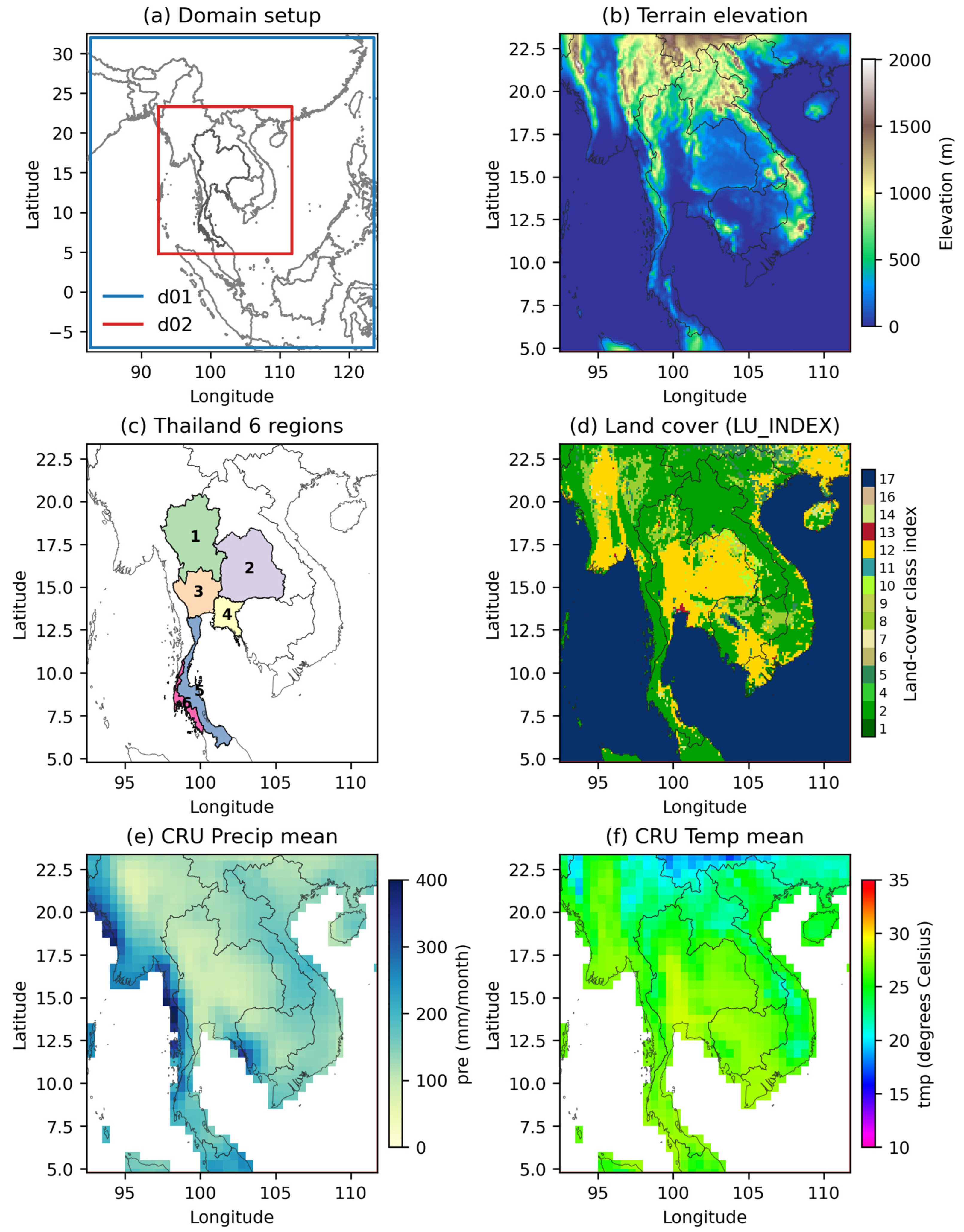

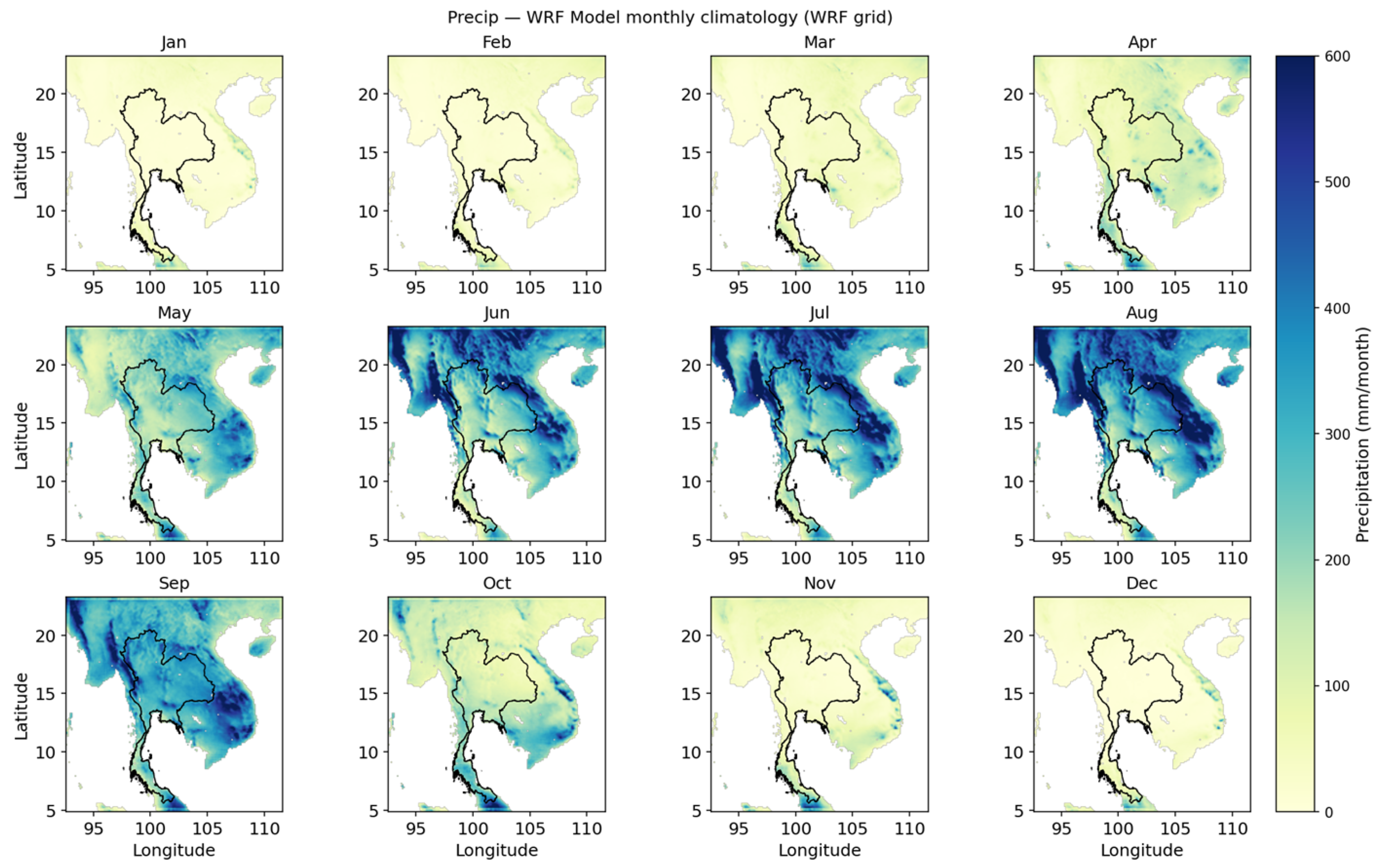
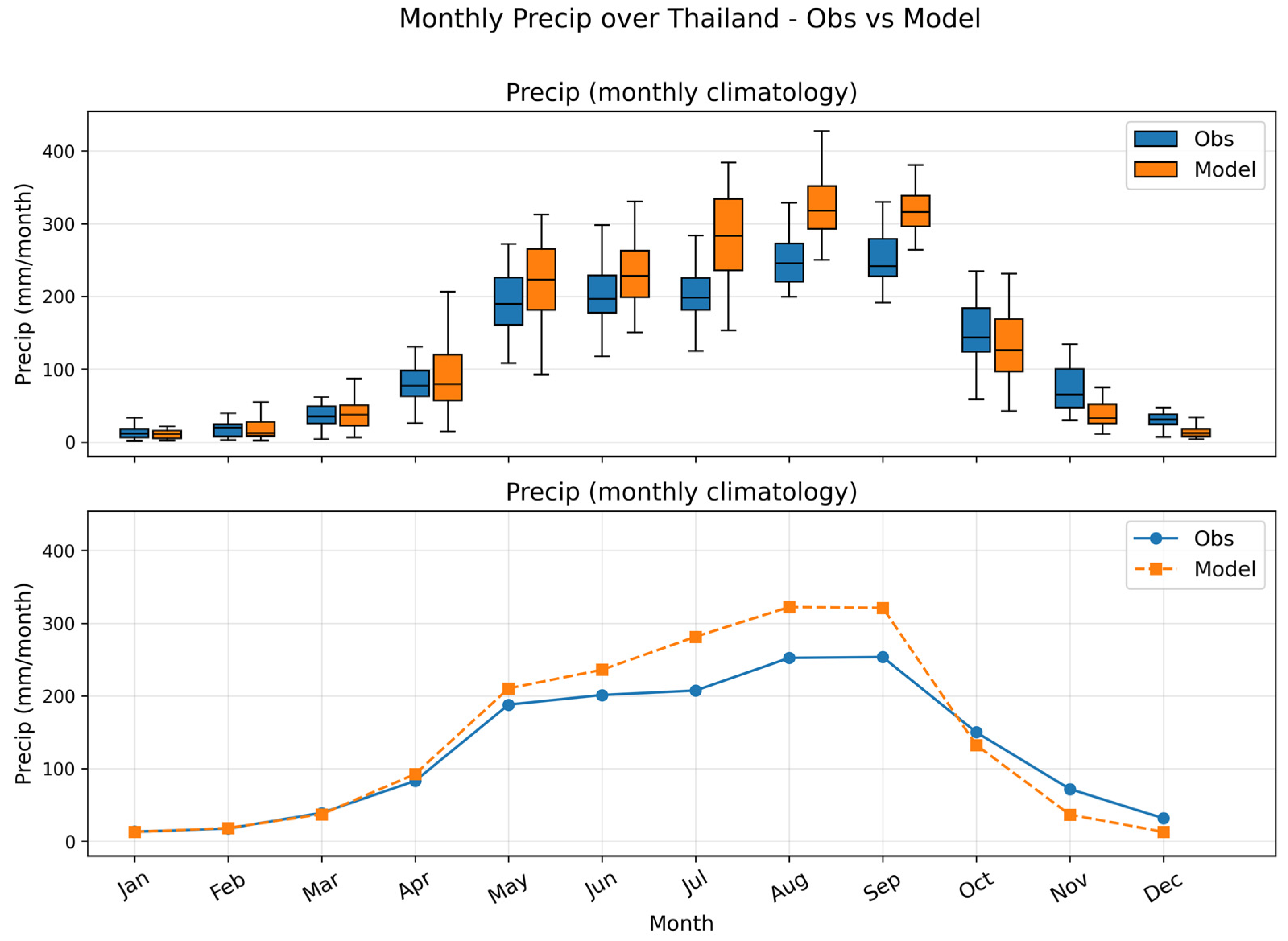
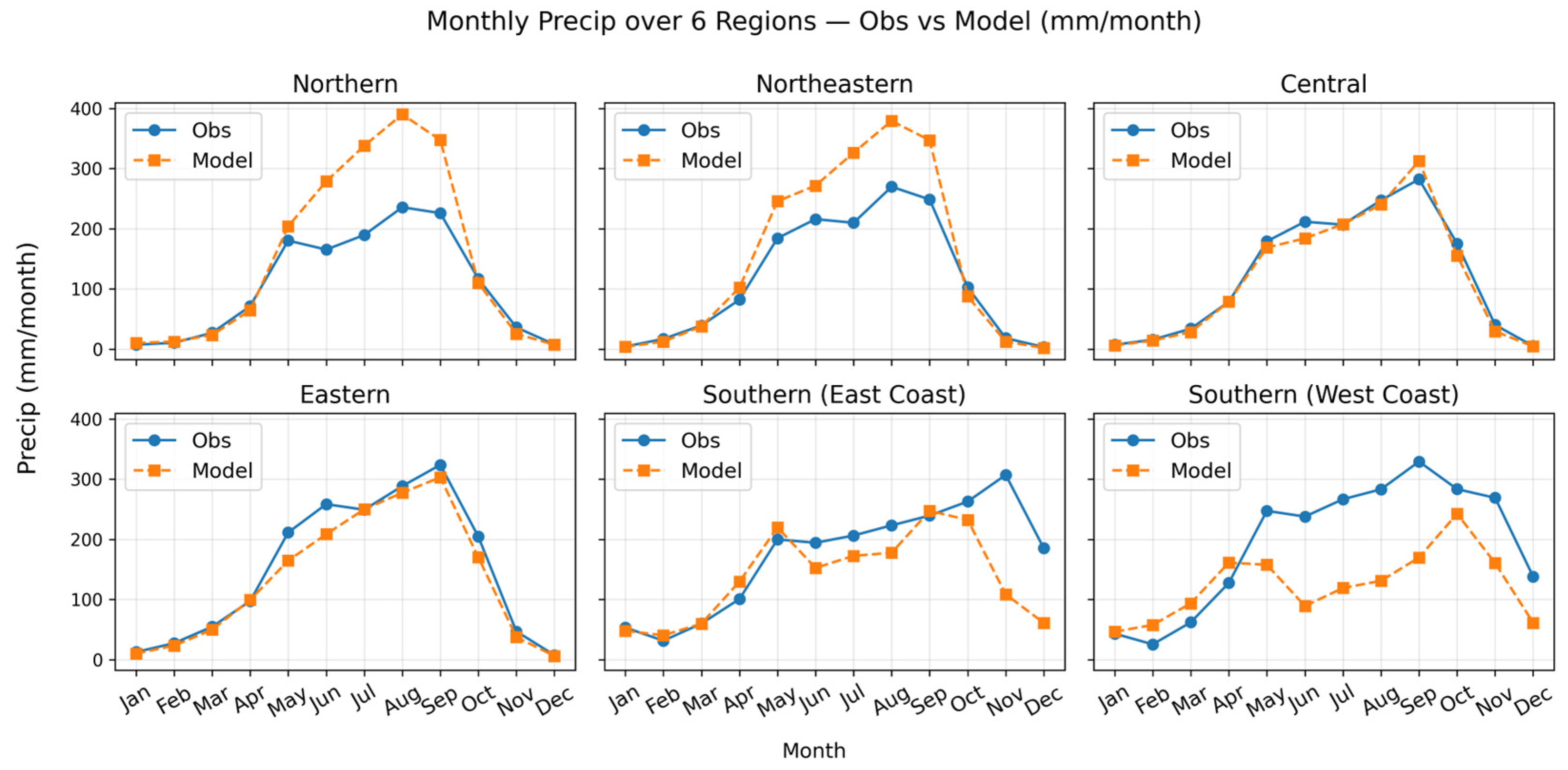

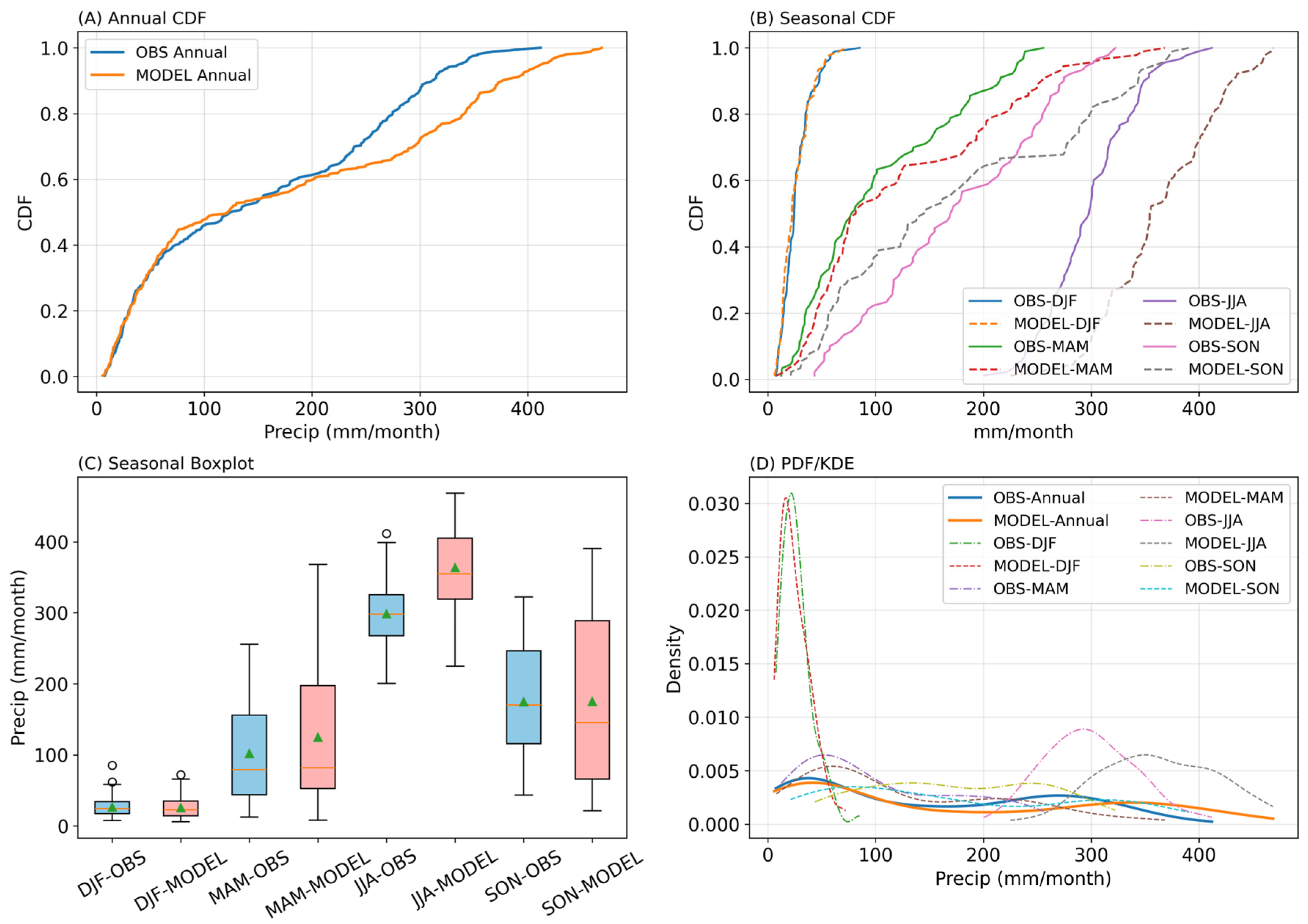
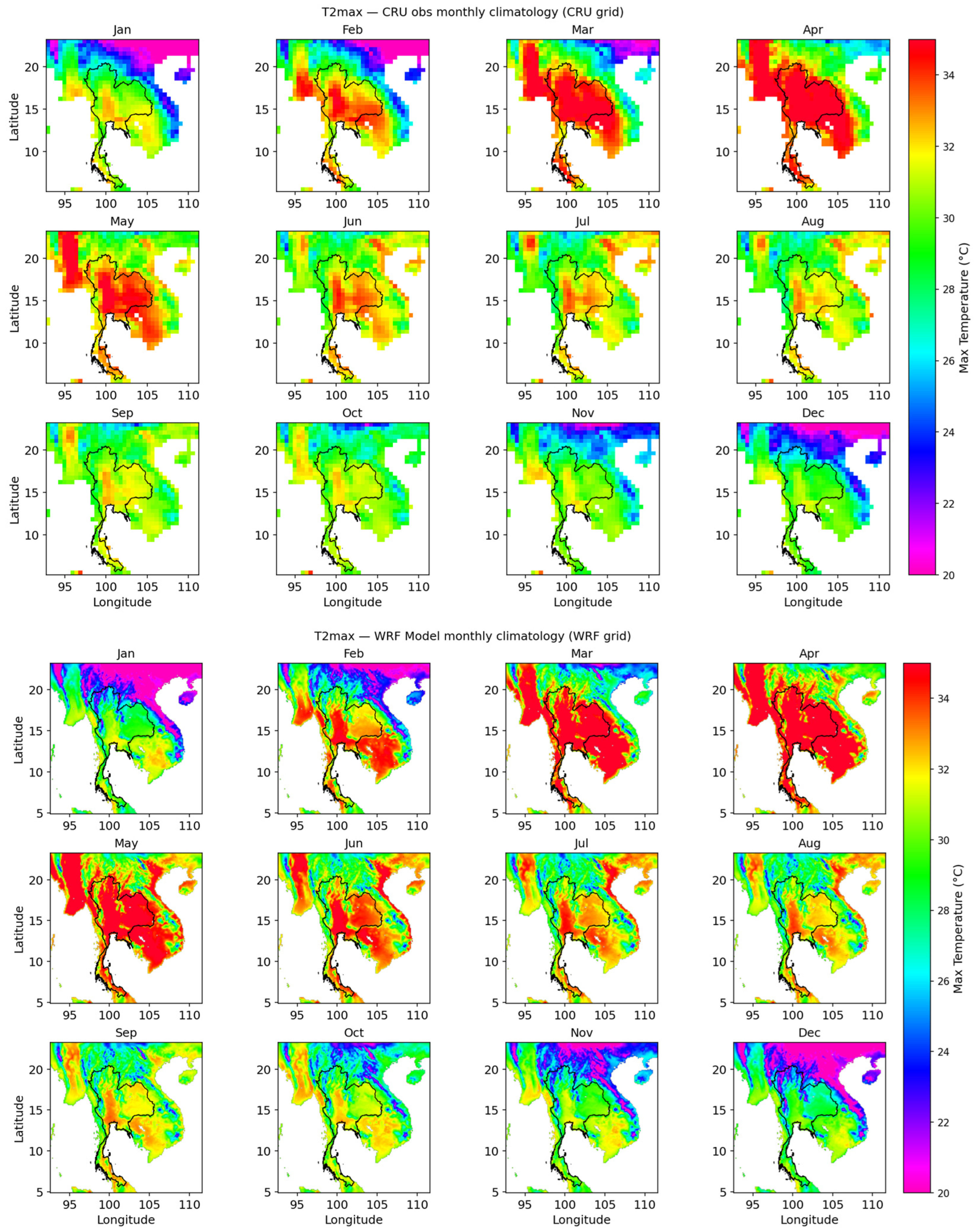



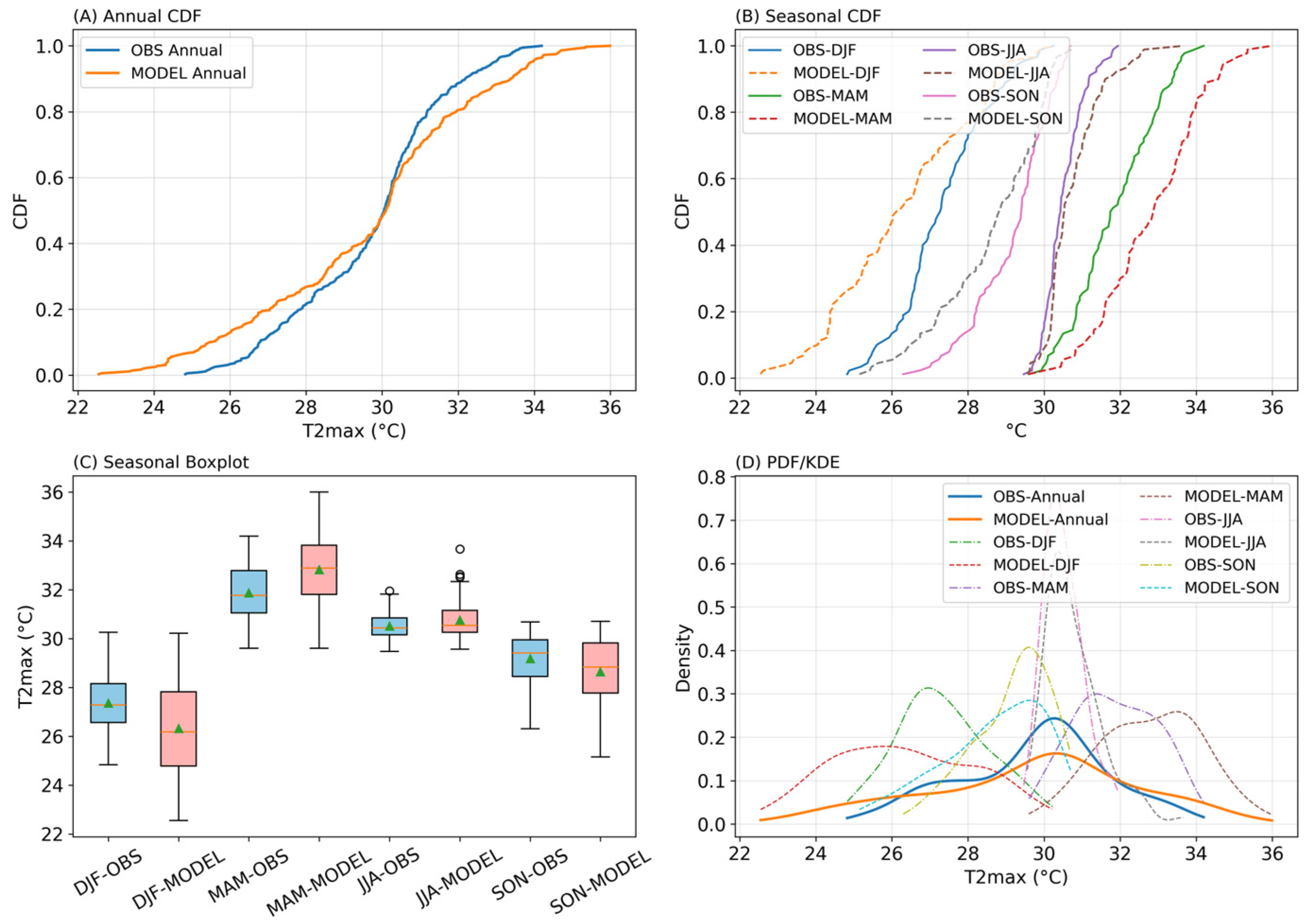
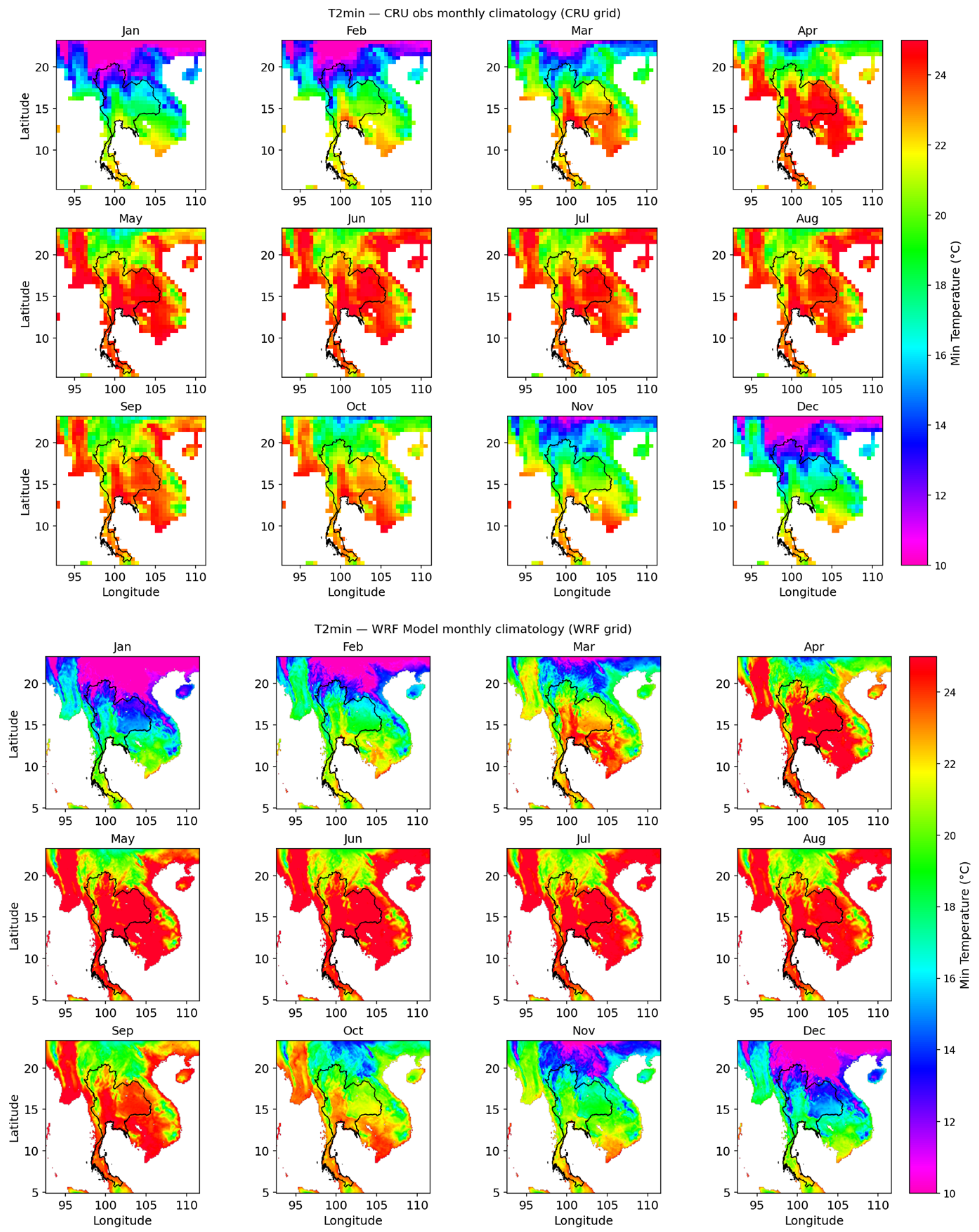

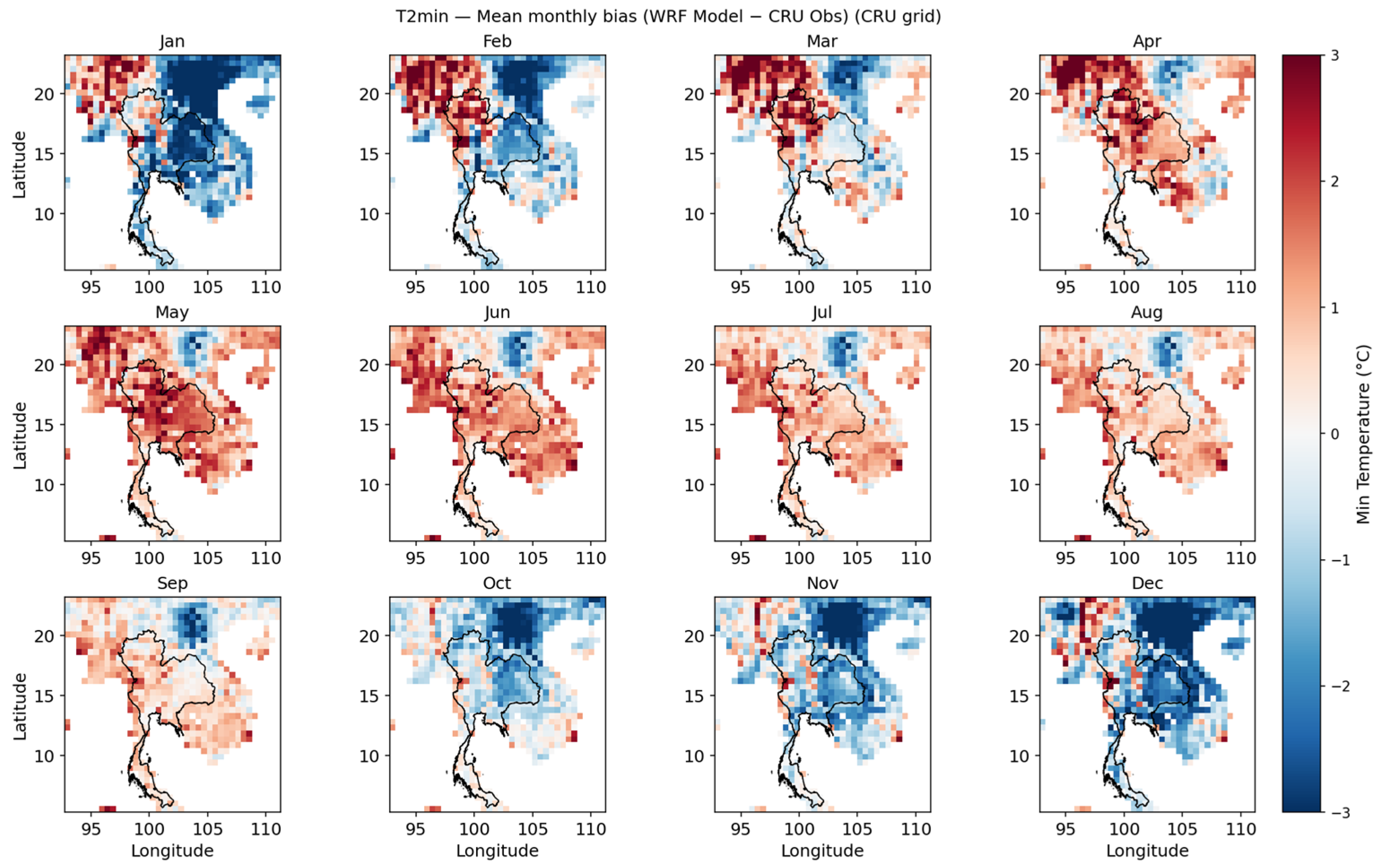
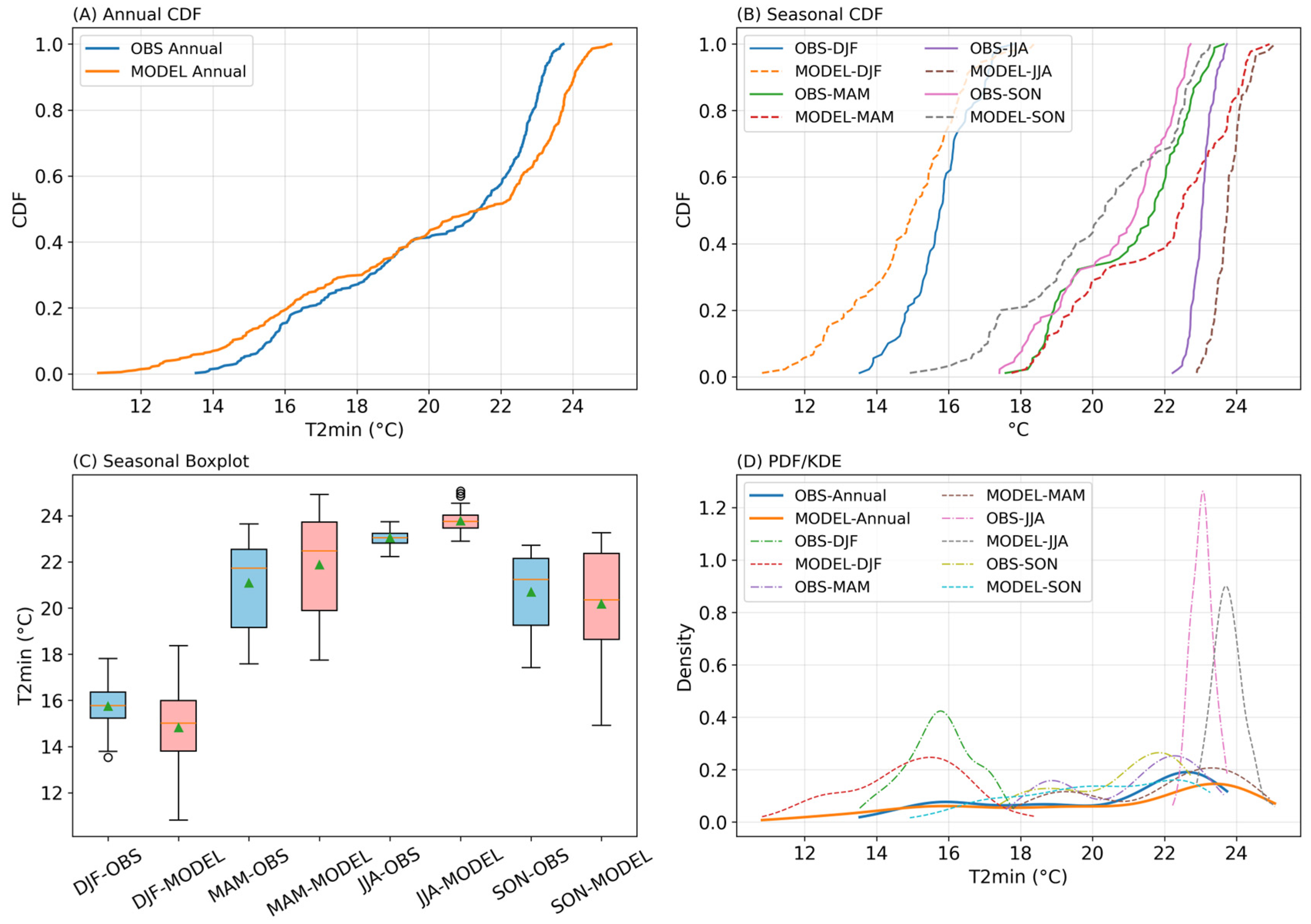

| Component | Scheme/Setting | Notes |
|---|---|---|
| Dynamical core | ARW (WRF v4.01) | Two-way nesting |
| Domains/Δx | d01: 36 km, d02: 12 km | Parent ratio 1:3 |
| Grid resolutions | d01: 125 × 125, d02: 175 × 175 | Centers Thailand; covers mainland SEA |
| Vertical levels/Top | 35 levels/50 hPa | data |
| LBC/update | CESM bias-corrected CMIP5/6-hourly | Monaghan et al. (2014) [34] |
| SST/lower boundary update | wrflowinp every 6 h | sst_update = 1 |
| Micro-physics | WSM6 | Hong and Lim (2006) [38] |
| Cumulus scheme | New Tiedtke | Kain, J.S. and Kain, J. (2004) [39] |
| PBL | YSU | Hong et al. (2006) [41] |
| Surface layer | Revised MM5 | Jiménez et al. (2012) [42] |
| Land surface model | Noah LSM | Chen and Dudhia (2001) [13] |
| Radiation (LW/SW) | RRTMG/RRTMG | Iacono et al. (2008) [40] |
| Urban parameterization | SLUCM | Kusaka et al. (2001) [43] |
| FDDA (grid nudging) | On d01 only | Excluding PBL |
| Period | Obs_Mean | Mod_Mean | Bais (mm/Month) | Bias (%) | KS_D | KS_P |
|---|---|---|---|---|---|---|
| Annual | 151 | 172 | 21.87 | 14.52 | 0.17 | 3.8 × 10−5 |
| DJF | 27 | 26 | −1.09 | −4.06 | 0.12 | 4.9 × 10−1 |
| MAM | 102 | 125 | 23.10 | 22.64 | 0.14 | 2.8 × 10−1 |
| JJA | 298 | 364 | 65.22 | 21.86 | 0.51 | 4.7 × 10−11 |
| SON | 175 | 175 | 0.24 | 0.14 | 0.23 | 1.2 × 10−2 |
| Period | Obs_Mean | Mod_Mean | Bais (°C/month) | Bias (%) | KS_D | KS_P |
|---|---|---|---|---|---|---|
| Annual | 29.7 | 29.6 | −0.09 | −0.32 | 0.11 | 3.35 × 10−2 |
| DJF | 27.3 | 26.3 | −1.04 | −3.79 | 0.37 | 6.76 × 10−6 |
| MAM | 31.9 | 32.8 | 0.95 | 2.97 | 0.31 | 2.30 × 10−4 |
| JJA | 30.5 | 30.8 | 0.24 | 0.80 | 0.16 | 2.07 × 10−1 |
| SON | 29.2 | 28.6 | −0.53 | −1.82 | 0.20 | 4.71 × 10−2 |
| Period | Obs_Mean | Mod_Mean | Bais (°C/Month) | Bias (%) | KS_D | KS_P |
|---|---|---|---|---|---|---|
| Annual | 20.1 | 20.2 | 0.02 | 0.12 | 0.25 | 3.6 × 10−10 |
| DJF | 15.8 | 14.8 | −0.92 | −5.86 | 0.30 | 4.4 × 10−4 |
| MAM | 21.1 | 21.9 | 0.79 | 3.74 | 0.30 | 4.4 × 10−4 |
| JJA | 23.0 | 23.8 | 0.74 | 3.21 | 0.70 | 2.3 × 10−20 |
| SON | 20.7 | 20.2 | −0.51 | −2.45 | 0.18 | 1.0 × 10−1 |
| Region | Variable | MBE | MAE | RMSE | r | KGE | PCC |
|---|---|---|---|---|---|---|---|
| Thailand | Precip | 17.14 | 46.68 | 63.88 | 0.88 | 0.62 | 0.23 |
| T2max | −1.25 | 1.58 | 1.99 | 0.83 | 0.55 | 0.89 | |
| T2min | −0.8 | 1.20 | 1.76 | 0.91 | 0.61 | 0.90 | |
| Northern | Precip | 44.79 | 68.32 | 101.79 | 0.83 | 0.22 | 0.71 |
| T2max | −1.50 | 1.91 | 2.36 | 0.83 | 0.54 | 0.92 | |
| T2min | −0.18 | 1.05 | 1.51 | 0.92 | 0.85 | 0.90 | |
| Northeastern | Precip | 36.06 | 57.75 | 86.30 | 0.88 | 0.44 | 0.88 |
| T2max | −1.17 | 1.58 | 2.02 | 0.83 | 0.55 | 0.66 | |
| T2min | −1.30 | 1.73 | 2.48 | 0.91 | 0.48 | 0.84 | |
| Central | Precip | −4.44 | 47.25 | 68.24 | 0.81 | 0.81 | 0.44 |
| T2max | −1.12 | 1.65 | 2.12 | 0.80 | 0.47 | 0.96 | |
| T2min | −0.86 | 1.28 | 1.93 | 0.88 | 0.49 | 0.92 | |
| Eastern | Precip | −15.23 | 55.71 | 80.62 | 0.80 | 0.76 | 0.22 |
| T2max | −1.05 | 1.38 | 1.77 | 0.71 | 0.52 | 0.79 | |
| T2min | −1.08 | 1.33 | 1.98 | 0.86 | 0.41 | 0.72 | |
| Southeast coast | Precip | −34.54 | 72.58 | 102.25 | 0.49 | 0.43 | 0.26 |
| T2max | −1.12 | 1.25 | 1.53 | 0.81 | 0.56 | 0.70 | |
| T2min | −0.72 | 0.83 | 1.22 | 0.75 | 0.42 | 0.71 | |
| Southwest coast | Precip | −68.58 | 104.58 | 129.62 | 0.45 | 0.25 | 0.44 |
| T2max | −1.12 | 1.20 | 1.45 | 0.76 | 0.75 | −0.89 | |
| T2min | −0.76 | 0.90 | 1.31 | 0.72 | 0.18 | −0.23 |
Disclaimer/Publisher’s Note: The statements, opinions and data contained in all publications are solely those of the individual author(s) and contributor(s) and not of MDPI and/or the editor(s). MDPI and/or the editor(s) disclaim responsibility for any injury to people or property resulting from any ideas, methods, instructions or products referred to in the content. |
© 2025 by the authors. Licensee MDPI, Basel, Switzerland. This article is an open access article distributed under the terms and conditions of the Creative Commons Attribution (CC BY) license (https://creativecommons.org/licenses/by/4.0/).
Share and Cite
Chotamonsak, C.; Lapyai, D.; Limsakul, A.; Torsri, K.; Thanadolmethaphorn, P.; Nakapan, S. Evaluation of WRF-Downscaled CMIP5 Climate Simulations for Precipitation and Temperature over Thailand (1976–2005): Implications for Adaptation and Sustainable Development. Sustainability 2025, 17, 9899. https://doi.org/10.3390/su17219899
Chotamonsak C, Lapyai D, Limsakul A, Torsri K, Thanadolmethaphorn P, Nakapan S. Evaluation of WRF-Downscaled CMIP5 Climate Simulations for Precipitation and Temperature over Thailand (1976–2005): Implications for Adaptation and Sustainable Development. Sustainability. 2025; 17(21):9899. https://doi.org/10.3390/su17219899
Chicago/Turabian StyleChotamonsak, Chakrit, Duangnapha Lapyai, Atsamon Limsakul, Kritanai Torsri, Punnathorn Thanadolmethaphorn, and Supachai Nakapan. 2025. "Evaluation of WRF-Downscaled CMIP5 Climate Simulations for Precipitation and Temperature over Thailand (1976–2005): Implications for Adaptation and Sustainable Development" Sustainability 17, no. 21: 9899. https://doi.org/10.3390/su17219899
APA StyleChotamonsak, C., Lapyai, D., Limsakul, A., Torsri, K., Thanadolmethaphorn, P., & Nakapan, S. (2025). Evaluation of WRF-Downscaled CMIP5 Climate Simulations for Precipitation and Temperature over Thailand (1976–2005): Implications for Adaptation and Sustainable Development. Sustainability, 17(21), 9899. https://doi.org/10.3390/su17219899









